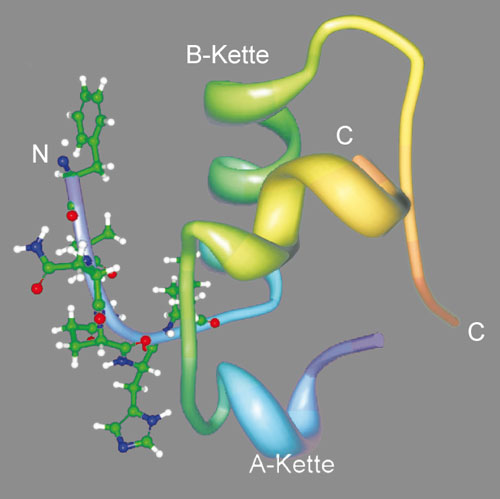The treatment of chronic diseases requires highly effective medication with minimal side-effects. The peptide hormone insulin plays a key role in the therapy of diabetes. As the number of people suffering from diabetes mellitus is steadily on the increase, the quantities of insulin produced have to rise accordingly. Nowadays, insulin is synthesized on a large scale with recombinant microorganisms. To use the protein molecules as active ingredients they are purified in a time-consuming and costly multi-stage process. Up to 50 percent of the manufacturing costs of protein therapeutics are incurred during the purification process. By means of effective artificial adsorbers or receptors which would reversibly bind the insulin, purification could be greatly simplified and thus become highly economic.
Artificial insulin receptors made of polymeric nanoparticles
The target: specific insulin receptors
The Institute for Interfacial Engineering (IGVT) of the University of Stuttgart is researching into the preparation of molecularly imprinted nanoparticles (MIPs, molecular imprinted polymers) binding insulin with great specificity and selectivity. The work is part of the program »Neue Materialien aus der Bionik« (New Bionic Materials) of the Baden-Württemberg Foundation.
The principle of molecular imprinting

Molecular imprinting is a process converting a polymerizable mixture with non-polymerizable target molecules – here insulin – into nanoscopically small polymeric beads. During the polymerization the insulin molecules act as molecular stamps, also called templates, which leave specific imprints for the peptide in the synthetic surface of the formed beads. Upon removal of the templates specific insulin recognition sites are formed in the nanostructured polymers – and artificial receptor nanoparticles are created (Fig. 1).
The challenge: binding sites

It may sound visionary, but with the process applied at the IGVT, it becomes generally feasible. A special challenge for the creation of artificial receptor nanoparticles for recombinant human insulin is posed by the design of the binding sites. By means of computer-aided evolutive processes we select those peptide sequences of the insulin molecule which appear particularly suited for a successful imprinting process: they should be specific for insulin and easily accessible on the insulin molecule. Theoretically the MIPs which have been imprinted with a specific peptide sequence, should recognize the complete molecule. So far we have defined three such sequences. One of them, consisting of six amino acids, can be seen in Figure 2 together with the insulin molecule.
Outlook
It is still a long way to the applicability of artificial receptors in the insulin purification process. Current high costs for insulin production in conjunction with the great demand for insulin form the basis for the long-term motivation of our research.
Funding
The project »Biomimetisches Insulin-Adsorbermaterial auf der Basis evolutiv entwickelter molekular geprägter Nanopartikel« (Biomimetic Insulin Adsorber Material on the Basis of Evolutively Developed Molecularly Imprinted Nanoparticles) was funded by the Baden-Württemberg Foundation within the scope of the program »Neue Materialien aus der Bionik« (New Bionic Materials).
Project partners
The experimental work at the Institute for Interfacial Engineering (IGVT) is accompanied by the analysis and evaluation of patent law and regulative conditions for artificial adsorber materials at the Institute for Human Factors and Technology Management (IAT) of the University of Stuttgart.
 Fraunhofer Institute for Interfacial Engineering and Biotechnology IGB
Fraunhofer Institute for Interfacial Engineering and Biotechnology IGB